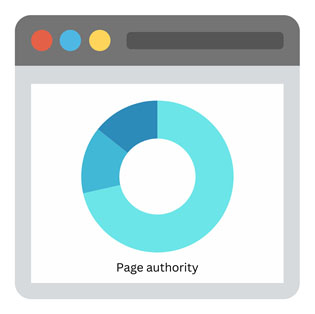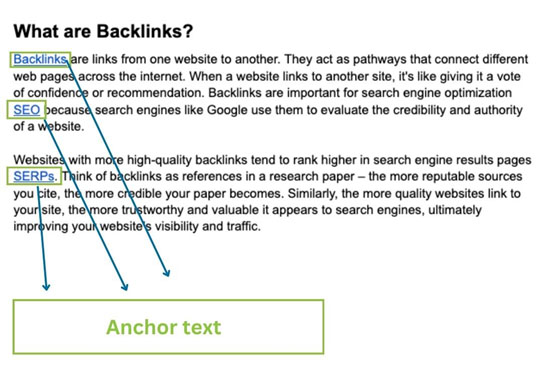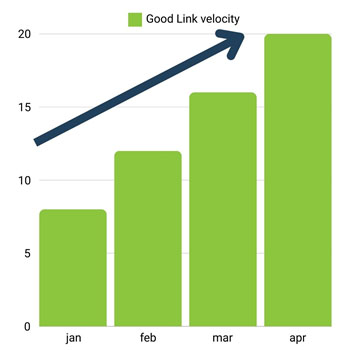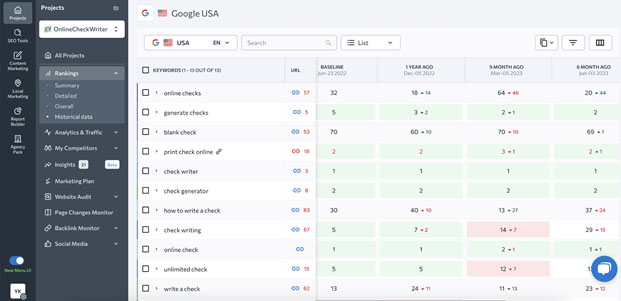Source domain authority
Source Domain Authority is like a score that tells us how trustworthy and important a website is. It’s kind of like giving a grade to a website based on how much other websites trust it. Websites with higher Domain Authority scores are seen as more reliable and respected by search engines like Google.

Think of it this way: If you’re looking for advice on a topic, you’d trust information from a well-known expert more than from someone you’ve never heard of, right? Similarly, when a website with a high Domain Authority links to another site, it’s like that expert vouching for the credibility of the linked site.
Metrics like Domain Authority (DA) or Domain Rating (DR) give us a quick way to understand how much influence a website has in the digital world. When analysing Backlinks, we pay attention to the Domain Authority of the websites linking to us to ensure we’re getting recommendations from reliable sources that will boost our own website’s credibility and reputation.
Page authority
Page Authority (PA) and URL Rating (UR) are metrics used to assess the authority and influence of specific web pages that link to your site. Think of it like this: each webpage on the internet has its own reputation, just like people do. PA and UR help us understand how influential and trustworthy a particular webpage is within the vast digital landscape.

Page Authority (PA) is a metric developed by Moz that predicts how well a specific webpage is likely to rank in search engine results. It considers various factors like the quality and quantity of Backlinks, as well as the content relevance and user experience of the page.
Similarly, URL Rating (UR) is a metric from Ahrefs that evaluates the strength of a webpage’s Backlink profile. It measures the quantity and quality of Backlinks pointing to that specific URL, giving insight into its authority and impact on search rankings.
By analysing Page Authority and URL Rating, website owners can gauge the influence and credibility of the pages linking to their site, helping them prioritise and optimise their link-building efforts for better SEO performance.
Relevance
When it comes to Backlinks, relevance is like finding the right puzzle piece for your website. Just as you wouldn’t force a square piece into a round hole, you want Backlinks that naturally fit with your content. Imagine your website is a book about cooking. If another website links to yours and talks about cooking tips or recipes, it’s like having a seamless chapter in your book. This alignment between the linking page’s content and your website’s topic or niche is crucial for ensuring that the Backlink adds value to both sides.
Think of it as having a conversation with someone who shares your interests. When the discussion stays on topic, it’s engaging and enriching. Similarly, when the content of the linking page relates to your website’s theme, it enhances the overall user experience and reinforces the credibility of your content. In essence, relevance ensures that the Backlink contributes meaningfully to the broader conversation within your niche, rather than feeling out of place or disconnected.
Link type
When it comes to Backlinks, there are two main types: Dofollow and Nofollow links. Dofollow links are like highways for search engines—they pass on “Link Equity,” which helps improve a website’s SEO and ranking. It’s like giving a thumbs-up to a website, saying, “Hey, this site is cool, check it out!” Search engines pay attention to these thumbs-ups and boost the ranking of the endorsed site accordingly.

On the other hand, Nofollow links are like back roads—they don’t pass on link equity, so they don’t directly affect a website’s SEO or ranking. However, they still serve a purpose. Nofollow links may not boost SEO, but they can drive traffic to a website if users click on them. It’s like getting a mention in a conversation—it might not boost your popularity, but it can still attract people who are interested in what you offer.
In summary, while Dofollow links are the gold standard for SEO because they boost rankings, Nofollow links shouldn’t be ignored. They may not have the same SEO benefits, but they can still bring valuable traffic to a website.
Anchor text
Anchor text refers to the clickable text in a hyperlink that directs users to another webpage. When analysing anchor text in Backlinks, it’s essential to ensure it’s relevant, natural, and diverse.
Relevance means that the anchor text should accurately describe the linked content, helping users understand what they’ll find when they click on the link. For example, if the anchor text is “best running shoes,” it should lead to a webpage discussing or selling running shoes.

Natural anchor text feels organic within the context of the content. It shouldn’t sound forced or overly promotional. Instead, it should seamlessly blend into the surrounding text, enhancing the reader’s experience.
Diversity in anchor text is crucial to avoid appearing spammy or overly optimised. Using a variety of anchor texts that reflect different keywords and phrases related to your content helps create a more natural link profile and avoids triggering search engine penalties.
By ensuring that anchor text is relevant, natural, and diverse, website owners can maintain a healthy Backlink profile that contributes positively to their SEO efforts, helping to improve rankings and attract more organic traffic.
Placement
When examining the placement of a Backlink, it’s like checking if a puzzle piece fits snugly into its spot. A natural and contextual Backlink seamlessly integrates into the content, enhancing the reader’s understanding or providing additional valuable information. It feels like a natural part of the conversation, adding to the overall flow and coherence of the text.
On the other hand, a forced or manipulative Backlink sticks out like a sore thumb. It disrupts the flow of the content, feels out of place, and may even detract from the reader’s experience. It’s like trying to cram a puzzle piece into a spot where it clearly doesn’t belong—it just doesn’t look right.
Search engines value natural and contextual Backlinks because they indicate genuine endorsements from other websites, whereas forced or manipulative placements can raise red flags and potentially harm a website’s SEO efforts. Therefore, it’s crucial to ensure that Backlinks are integrated seamlessly into content, contributing positively to the user experience and enhancing the credibility of the linked websites.
Link velocity
Link velocity refers to the speed at which a website gains new Backlinks over time. Imagine your website as a garden, and each Backlink is like a new plant growing. Just like you wouldn’t want all the plants to sprout at once in your garden, you don’t want too many Backlinks flooding to your website too quickly.

Search engines, like Google, want to see a natural and steady growth pattern of Backlinks. If your website suddenly gains an overwhelming number of Backlinks in a short period, it might raise red flags. It’s like if your garden suddenly bloomed with flowers overnight—it might look suspicious!
A natural link velocity signals to search engines that your website is earning Backlinks organically, which is a good thing. It shows that other websites find your content valuable and worth linking to over time. However, if the growth rate is too fast or too slow, it could appear unnatural, potentially leading to penalties from search engines.
Therefore, it’s essential to monitor your link velocity and ensure it follows a gradual and consistent pattern, just like nurturing a healthy garden to grow steadily over time.
Link quality
Assessing the quality of a linking website goes beyond just looking at its content. It involves considering various factors that affect the overall user experience and trustworthiness of the site.
Firstly, site speed is crucial because nobody likes waiting forever for a page to load. A fast-loading website ensures a smooth and enjoyable browsing experience.
Next, mobile-friendliness is essential because many people use smartphones and tablets to surf the web. A mobile-friendly site adjusts its layout and content to fit smaller screens, making it easier to navigate and read.
Security is also vital. Websites with HTTPS encryption provide a secure connection, protecting users’ data from being intercepted by hackers. Seeing that little padlock icon in the browser’s address bar instils confidence in visitors.
Lastly, user experience encompasses everything from intuitive navigation to clear and informative content. A well-designed website with easy-to-find information keeps visitors engaged and coming back for more.
By considering these factors, we can gauge the overall quality of a linking website, ensuring that the Backlinks it provides contribute positively to our own site’s credibility and authority.
Historical data
Historical data in Backlink analysis refers to tracking the performance and consistency of Backlinks over time. Just like looking at a friend’s track record before trusting their advice, assessing a Backlink’s history helps determine its reliability and impact on SEO. By monitoring how a Backlink has behaved in the past, such as whether it has remained active or if there have been sudden changes, website owners can anticipate how it might affect their site’s ranking in the future.

Imagine you’re choosing teammates for a game. You’d want to pick someone who has a consistent record of showing up and playing well, right? Similarly, in Backlink analysis, historical data helps identify Backlinks that have consistently contributed positively to SEO and those that may have caused fluctuations or penalties in the past. By keeping an eye on this historical performance, website owners can make informed decisions about which Backlinks to prioritise, ensuring a stable and effective link-building strategy over time.
Competitor analysis
Analysing your competitors’ Backlink profiles can provide valuable insights into their strategies and help you improve your own link-building efforts. Start by identifying your main competitors in your industry or niche. Then, use tools like Ahrefs or Moz to examine their Backlinks.
Look for patterns and trends in their Backlink profiles. Pay attention to the types of websites linking to them, the anchor text used, and the overall quality of their Backlinks. Are there any high-authority websites linking to them that you could also reach out to? Are there any relevant directories or industry-specific websites they are listed on that you could also leverage?
Additionally, analyse the content that is attracting Backlinks for your competitors. Is there a particular topic or type of content that seems to resonate well with their audience? Use this information to inform your own content strategy and create similar, valuable content that has the potential to attract Backlinks.
By conducting a thorough competitor analysis of their Backlink profiles, you can uncover opportunities to strengthen your own link-building strategy and improve your website’s SEO performance.
Conclusion
In conclusion, understanding the technical aspects of Backlink analysis is crucial for optimizing website performance and improving search engine rankings. By delving into factors such as anchor text, link attributes, and domain authority, website owners can gain valuable insights into the quality and effectiveness of their Backlink profile.
Just as a sturdy foundation is essential for a building’s stability, ensuring technical factors like link relevancy, diversity, and naturalness is vital for a robust Backlink strategy. Through continuous monitoring and analysis of these technical elements, website owners can identify areas for improvement, refine their link-building efforts, and ultimately enhance their online visibility and authority.
By exploring the technicalities of Backlink analysis and applying them in a practical and relatable manner, website owners can navigate the complexities of SEO with confidence and achieve sustainable success in the competitive digital landscape.